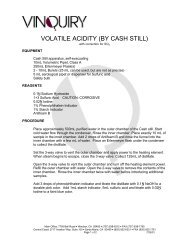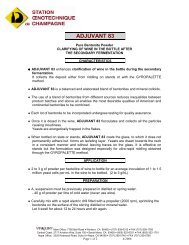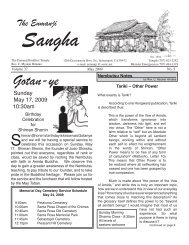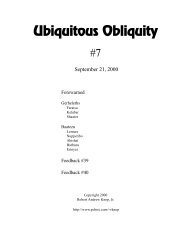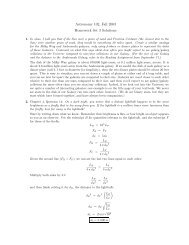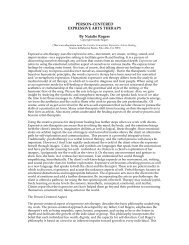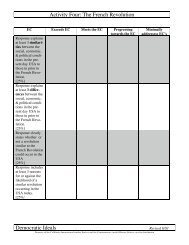John Bollinger on consolidations - Sonic.net
John Bollinger on consolidations - Sonic.net
John Bollinger on consolidations - Sonic.net
You also want an ePaper? Increase the reach of your titles
YUMPU automatically turns print PDFs into web optimized ePapers that Google loves.
MONEY TALKS c<strong>on</strong>tinued<br />
wasn’t unusual <strong>on</strong>e way or the other.<br />
JB: Well, first of all, I’m working with the relative definiti<strong>on</strong><br />
of high and low price levels, so that lets me know when<br />
to c<strong>on</strong>sult volume.<br />
For example, if price has just tagged the upper band, I<br />
know this is a point to see if volume is adding anything to<br />
the picture. I d<strong>on</strong>’t scan volume c<strong>on</strong>tinuously, trying to<br />
make an <strong>on</strong>going stream of decisi<strong>on</strong>s based <strong>on</strong> the relati<strong>on</strong>ship<br />
between it and price. I <strong>on</strong>ly look at critical junctures.<br />
What I’ve found, in this regard, is that it pays to wait. In<br />
other words, after I get a buy or sell signal, I wait for price<br />
FIGURE 1 — BOLLINGER BANDS: USD/JPY<br />
Notice the many touches and minor pe<strong>net</strong>rati<strong>on</strong>s of the lower band during the<br />
October-November downtrend; price never approaches the upper band during<br />
this period an <strong>on</strong>ly pe<strong>net</strong>rates the moving average (middle line) <strong>on</strong>ce. The<br />
December-January trading range is characterized by much more even swings<br />
between the two bands. Finally, notice the c<strong>on</strong>tracti<strong>on</strong> of the bands during the<br />
low-volatility September c<strong>on</strong>solidati<strong>on</strong> vs. the expansi<strong>on</strong> of the bands as volatility<br />
increases in October.<br />
U.S. dollar/Japanese yen (USD/JPY), daily<br />
Sept. Oct. Nov. Dec. 2005 Feb.<br />
Source: TradeStati<strong>on</strong><br />
acti<strong>on</strong> to c<strong>on</strong>firm that signal. If price tags the upper band<br />
and a volume indicator — say, 20-day <strong>on</strong> balance volume<br />
(OBV) — is in negative territory, you can treat that as a<br />
warning or alert because the combinati<strong>on</strong> suggests this is a<br />
potentially unsustainable situati<strong>on</strong>. Then, if there’s evidence<br />
of a decline, you can act, because you know a proper<br />
setup was in place.<br />
The other thing you have going for you in this kind of<br />
trade situati<strong>on</strong> is knowing whether there’s a good riskreward<br />
relati<strong>on</strong>ship. If price tags the upper band and turns<br />
down, you can place a stop just above the entry point,<br />
knowing if price goes back up and violates the stop, your<br />
setup is broken. And that stop will be fairly close by, so the<br />
amount you’re risking is relatively small, whereas the<br />
immediate target for the move is for price to get back to the<br />
lower band, which is much farther away.<br />
CT: What kind of risk-reward numbers do you operate with?<br />
JB: Here’s <strong>on</strong>e way to look at it: There are <strong>on</strong>ly two ways<br />
to improve your trading performance. First, you can<br />
increase your number of winning trades vs. losing trades. If<br />
you’re batting around .500, you can try to add different timing<br />
informati<strong>on</strong> and indicators, and so <strong>on</strong>, and maybe get<br />
your batting average up to around .600 or .650. I think<br />
you’re doing pretty well if you have 65<br />
percent winners.<br />
112<br />
111<br />
110<br />
109<br />
108<br />
107<br />
106<br />
105<br />
104<br />
103<br />
Sec<strong>on</strong>d, you can increase the size of<br />
your winners vs. the size of your losers.<br />
Say your winners are twice the<br />
size of your losers — that’s pretty<br />
good. If you get up to three times the<br />
size, I think you’ll find the mathematics<br />
work very much in your favor. If<br />
you have 60 to 65 percent winning<br />
trades and your winners are two to<br />
three times the size of your losers,<br />
you’ll find you’re making m<strong>on</strong>ey pretty<br />
quickly.<br />
By using this relative trading<br />
approach, you can address both those<br />
risk-reward dimensi<strong>on</strong>s. You address<br />
the size of the winners vs. losers by<br />
having entry points with logical [stop]<br />
points nearby that let you know your<br />
trade was wr<strong>on</strong>g. You address the<br />
number of winners by finding the<br />
right volume indicators to assess the<br />
type of trade and the vehicles you’re<br />
using.<br />
102<br />
CT: What about a trend comp<strong>on</strong>ent<br />
that’s independent from what you’re<br />
discussing now — independent in that<br />
it would probably be <strong>on</strong> a l<strong>on</strong>ger time<br />
frame?<br />
JB: I think the idea of biasing your trading in the directi<strong>on</strong><br />
of the greatest probability of success is very important. In a<br />
sideways market, you’ll get fairly important intermediateterm<br />
buy signals near the bottom of the range and sell signals<br />
near the top. Those should absolutely dictate the directi<strong>on</strong><br />
of your trading. Clearly, if you can bias your trading in<br />
favor of the intermediate swing directi<strong>on</strong> of the market,<br />
you’ll go a l<strong>on</strong>g way toward improving the two key comp<strong>on</strong>ents<br />
of success.<br />
In terms of time frame, if you’re using <str<strong>on</strong>g>Bollinger</str<strong>on</strong>g> Bands,<br />
for example, rather than trying to adjust the time frame by<br />
changing the periods and width of the bands — 20 and 2<br />
seem to work very well for most applicati<strong>on</strong>s and are cer-<br />
38 March 2005 • CURRENCY TRADER





